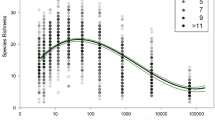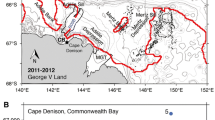Abstract
Ice scour disturbance has a significant effect on the physical and biological characteristics of polar benthos. A series of grids, each consisting of 25 markers, were deployed along depth transects and replicated at two contrasting study sites at Adelaide Island, West Antarctic Peninsula. Markers were surveyed and replaced every 3 months for 2 years in order to assess the frequency and intensity of iceberg impacts. Depth, site, season and year were all highly significant factors influencing ice scouring frequency. We observed a high variation in the duration of winter fast ice between sites and years, which had a marked effect on ice scouring frequency. The ecological effects of the disturbance regime are likely to include depth zonation of benthic assemblages, patchiness of communities at varying stages of recovery and the near denudation of sessile fauna in the shallow subtidal.









Similar content being viewed by others
Notes
N. B. Hangar Cove was referred to as ‘North Cove’ by Brown et al. (2004).
References
Barnes DKA (1995a) Sublittoral epifaunal communities at Signy Island, Antarctica. I. The ice-foot zone. Mar Biol 121:555–563
Barnes DKA (1995b) Sublittoral epifaunal communities at Signy Island, Antarctica. II. Below the ice-foot zone. Mar Biol 121:565–572
Barnes DKA (1999) The influence of ice on polar nearshore benthos. J Mar Biolog Assoc UK 79:401–407
Barnes DKA (2002) Polarisation of competition increases with latitude. Proc R Soc Lond B Biol Sci 1504:2061–2069
Barnes DKA, Brockington S (2003) Zoobenthic biodiversity, biomass and abundance at Adelaide Island, Antarctica. Mar Ecol Prog Ser 249:145–155
Brenner M, Buck B, Cordes S, Dietrich L, Jacob U, Mintenbeck A, Schroder A, Brey T, Knust R, Arntz WE (2001) The role of iceberg scours in niche separation within the Antarctic fish genus Trematomus. Polar Biol 24:502–507
Brouwer PEM, Geilen EFM, Gremmen NJM, Van Lent F (1995) Biomass, cover and zonation pattern of sublittoral macroalgae at Signy Island, South Orkney Islands, Antarctica. Bot Mar 38:259–270
Brown KM, Fraser KPP, Barnes DKA, Peck LS (2004) Links between the structure of an Antarctic shallow-water community and ice-scour frequency. Oecologia 141:121–129
Bruno JF, Stachowicz JJ, Bertness MD (2003) Inclusion of facilitation into ecological theory. Trends Ecol Evol 18:119–125
Cavalieri DJ, Gloersen P, Parkinson CL, Comiso JC, Zwally HJ (1997) Observed hemispheric asymmetry in global sea ice changes. Science 278:1104–1106
Clarke A (1988) Seasonality in the Antarctic marine environment. Comp Biochem Physiol 90B:461–473
Conlan KE, Kvitek RG (2005) Recolonization of soft-sediment ice scours on an exposed Arctic coast. Mar Ecol Prog Ser 286:21–42
Conlan KE, Lenihan HS, Kvitek RG, Oliver JS (1998) Ice scour disturbance to benthic communities in the Canadian High Arctic. Mar Ecol Prog Ser 166:1–16
Dayton PK, Robbiliard GA, Paine RT (1969) Anchor ice formation at McMurdo Sound, Antarctica, and its biological effects. Science 163:273–274
Dayton PK, Robbiliard GA, Paine RT, Dayton LB (1974) Biological accomodation in the benthic community at McMurdo Sound, Antarctica. Ecol Monogr 44:105–128
de la Mare WK (1997) Abrupt mid-twentieth-century decline in Antarctic sea-ice extent from whaling records. Nature 389:57–60
Denny MW (1988) Biology and the mechanics of the wave-swept environment. Princeton University Press, Princeton
Dexter DM (1992) Sandy beach communtiy structure: the role of exposure and latitude. J Biogeogr 9:59–66
Dowdeswell JA, Villinger H, Whittington RJ, Marienfeld P (1993) Iceberg scouring in Scoresby Sund and on the East Greenland continental shelf. Mar Geol 111:37–53
Gambi MC, Lorenti M, Russo GF, Scipioni MB (1994) Benthic associations of the shallow hard bottoms off Terra Nova Bay, Ross Sea: zonation, biomass and population structure. Antarct Sci 6:449–462
Gambi MC, Buia MC, Mazzella L, Lorenti M, Scipioni MB (2000) Spatio-temporal variability in the structure of benthic populations in a physically controlled system off Terra Nova Bay: the shallow hard bottoms. In: Faranda F, Guglielmo L, Ionora A (eds) Ross sea ecology. Springer, Berlin Heidelberg New York
Gerdes D, Hilbig B, Montiel A (2003) Impact of iceberg scouring on macrobenthic communities in the high-Antarctic Weddell Sea. Polar Biol 26:295–301
Gutt J (2000) Some “driving forces” structuring communities of the sublittoral Antarctic macrobenthos. Antarct Sci 12:297–313
Gutt J (2001) On the direct impact of ice on marine benthic communities, a review. Polar Biol 24:553–564
Gutt J, Piepenburg D (2003) Scale-dependent impact on diversity of Antarctic benthos caused by grounding of icebergs. Mar Ecol Prog Ser 253:77–83
Gutt J, Starmans A (2001) Quantification of iceberg impact and benthic recolonisation patterns in the Weddell Sea (Antarctica). Polar Biol 24:615–619
Gutt J, Starmans A, Dieckmann G (1996) Impact of iceberg scouring on polar benthic habitats. Mar Ecol Prog Ser 137:311–316
Haykin S, Lewis EO, Raney RK, Rossiter JR (1994) Remote sensing of sea ice and icebergs. Wiley, New York
Hotzel SI, Miller JD (1983) Icebergs: their physical dimensions and the presentation and application of measured data. Ann Glaciol 4:116–123
Jacka TH (1990) Antarctic and Southern Ocean sea-ice and climate trends. Ann Glaciol 14:127–130
Jacobs SS, Comiso JC (1993) A recent sea-ice retreat west of the Antarctic Peninsula. Geophys Res Lett 20:1171–1174
Lee HJ, Vanhove S, Peck LS, Vincx M (2001) Recolonisation of meiofauna after catastrophic iceberg scouring in shallow Antarctic sediments. Polar Biol 24:918–925
Lien R, Solheim A, Elverhii A, Rokoengen K (1989) Iceberg scouring and sea bed morphology on the easten Weddell Sea shelf, Antarctica. Polar Res 7:43–57
McCook LJ, Chapman ARO (1993) Community succession following massive ice-scour on a rocky intertidal shore: recruitment, competition and predation during early, primary succession. Mar Biol 115:565–575
Murphy EJ, Clarke A, Symon C, Priddle J (1995) Temporal variation in Antarctic sea-ice: analysis of a long term fast-ice record from the South Orkney Islands. Deep Sea Res 42:1045–1062
Nonato EF, Brito TAS, De Paiva PC, Petti MAV, Corbisier TN (2000) Benthic megafauna of the nearshore zone of Martel Inlet (King George Island, South Shetland Islands, Antarctica): depth zonation and underwater observations. Polar Biol 23:580–588
Peck LS, Bullough LW (1993) Growth and population structure in the infaunal bivalve Yoldia eightsi in relation to iceberg activity at Signy Island, Antarctica. Mar Biol 117:235–241
Peck LS, Brockington S, Vanhove S, Beghyn M (1999) Community recovery following catastrophic iceberg impacts in a soft-sediment shallow-water site at Signy Island, Antarctica. Mar Ecol Prog Ser 186:1–8
Pugh PJA, Davenport J (1997) Colonisation vs. disturbance: the effects of sustained ice-scouring on intertidal communities. J Exp Mar Biol Ecol 210:1–21
Rearic DM, Barnes PW, Reimnitz E (1990) Bulldozing and resuspension of shallow-shelf sediment by iceberg keels: implications for Arctic sediment transport trajectories. Mar Geol 91:133–147
Reimnitz E, Barnes PW, Toimil LJ, Melchior J (1977) Ice gouge recurrence and rates of sediment reworking, Beaufort Sea, Alaska. Geology 5:405–408
Richardson ME, Hedgepeth JW (1977) Antarctic soft-bottom, macrobenthic community adaptations to a cold, stable, highly productive, glacially affected environment. In: Llano GA (ed) Adaptations within Antarctic ecosystems. Smithsonian Institution Press, Washington, pp 181–196
Sahade R, Tatian M, Kowalke J, Kuhne S, Esnal GB (1998) Benthic faunal associations on soft substrates at Potter Cove, King George Island, Antarctica. Polar Biol 19:85–91
Scrosati R, Heaven C (2006) Field technique to quantify the intensity of scouring by sea ice on rocky intertidal habitats. Mar Ecol Prog Ser 320:293–295
Smith RC, Stammerjohn S (2001) Variations of surface air temperature and sea ice extent in the West Antarctic Peninsula (WAP) region. Ann Glaciol 33:493–500
Sousa WP (1979) Disturbance in marine intertidal boulder fields: the nonequilibrium maintenance of species diversity. Ecology 60:1225–1239
Sousa WP (1984) The role of disturbance in natural communities. Annu Rev Ecol Syst 15:353–391
Underwood AJ, Jernakoff P (1984) Effects of tidal height, wave exposure, seasonality and rock pools on grazing and the distribution of macroalgae in New South Wales. J Exp Mar Biol Ecol 75:71–96
Waller C, Barnes DKA, Convey P (2006) Ecological constraints across an Antarctic land–sea interface. Austral Ecol 31:656–666
WMO (1970) World Meterological Organization sea-ice nomenclature. Terminology, codes and illustrated glossary. In: WMO/OMM.BMO, vol 259, pp 145
Woodworth-Lynas CMT, Josenhans HW, Barrie JV, Lewis CFM, Parrott DR (1991) The physical processes of seabed disturbance during iceberg grounding and scouring. Cont Shelf Res 11:939–961
Acknowledgments
The authors acknowledge the essential work of Kirsty Brown concerning the development of the field technique. We thank Pete Rothery for statistical advice. We are grateful to all the members of the 2004 and 2005 marine teams at Rothera Research Station, but particularly for the hard work of the Dive Officers (John Withers and Matt Brown) during this project. Finally, we thank M. C. Gambi and two anonymous referees for their constructive comments.
Author information
Authors and Affiliations
Corresponding author
Rights and permissions
About this article
Cite this article
Smale, D.A., Barnes, D.K.A. & Fraser, K.P.P. The influence of depth, site exposure and season on the intensity of iceberg scouring in nearshore Antarctic waters. Polar Biol 30, 769–779 (2007). https://doi.org/10.1007/s00300-006-0236-0
Received:
Revised:
Accepted:
Published:
Issue Date:
DOI: https://doi.org/10.1007/s00300-006-0236-0




